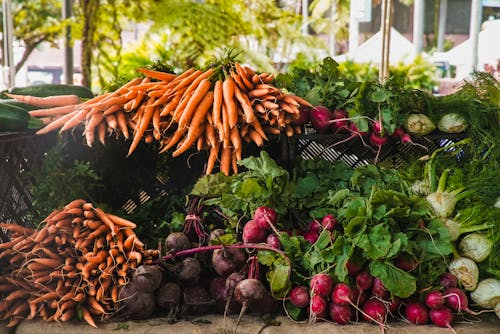The farm-to-table movement has gained significant momentum over the past few decades, as more people seek out fresh, locally sourced food that supports healthier eating habits, strengthens local economies, and promotes sustainability. This movement emphasizes the importance of directly connecting consumers with local farmers, allowing individuals to enjoy the freshest produce, meats, and dairy while fostering a stronger connection to the food they eat. In this article, we’ll explore the many benefits of eating locally sourced food, from improving personal health to benefiting the environment and local communities.

Health Benefits of Eating Locally Sourced Food
One of the most compelling reasons people turn to farm-to-table eating is its potential to improve health. Locally sourced food is typically fresher, more nutrient-dense, and free from preservatives and chemicals often used in mass-produced goods.
- Freshness and Nutrient Density: Local food is often harvested at its peak ripeness and delivered quickly to consumers. The shorter the time between harvest and consumption, the more nutrients the food retains. In contrast, produce that is grown far away and transported long distances often loses nutrients during transit and storage. Freshly picked fruits and vegetables provide higher levels of vitamins, antioxidants, and minerals, supporting a healthier diet.
- Fewer Pesticides and Chemicals: Many local farmers adopt organic or sustainable farming practices, using fewer harmful chemicals or pesticides. By choosing locally sourced food, consumers may reduce their exposure to these chemicals, which can have long-term health effects. Additionally, some small-scale local farms may engage in regenerative agriculture, promoting healthier soil and food.
- Support for Special Diets: Farm-to-table dining often caters to a variety of specific dietary needs, such as gluten-free, vegan, or low-carb diets. With more direct access to the origin of their food, consumers can feel more confident in the quality and sourcing of ingredients, making it easier to adhere to personalized nutrition plans.

Economic Impact: Supporting Local Farmers and Businesses
The farm-to-table movement has a direct, positive impact on local economies by providing support to small farmers and local food producers. This shift in consumer behavior has helped revitalize rural economies, create jobs, and strengthen the relationship between consumers and the agricultural sector.
- Boosting Local Farmers: Local farmers are often at the heart of the farm-to-table movement, and by purchasing locally grown food, consumers help sustain their livelihoods. Buying directly from farmers markets or local food cooperatives ensures that more money stays within the community and supports family-run farms that might otherwise struggle against large-scale commercial agriculture.
- Job Creation: The farm-to-table industry creates jobs not only for farmers but also for food distributors, restaurant owners, chefs, and food artisans. By fostering a demand for local food products, the movement provides economic opportunities across a range of industries, from agriculture to hospitality.
- Reduced Middlemen: When food is sold locally, fewer middlemen (like large distributors and supermarkets) are involved. This often means that farmers can receive a larger share of the profits, while consumers can benefit from more affordable prices and access to fresher products.
- Revitalizing Communities: In many regions, farm-to-table movements have helped revitalize declining rural communities. The demand for local food has spurred the growth of farmers markets, co-ops, and local food restaurants, creating vibrant spaces that foster social and economic connections within towns and cities.
Sustainability and Environmental Benefits
One of the core principles of the farm-to-table movement is sustainability. By reducing the distance food travels from farm to plate, locally sourced food helps reduce carbon footprints, supports environmental conservation efforts, and promotes more sustainable agricultural practices.
- Reduced Carbon Footprint: Transporting food over long distances requires significant fuel and energy, contributing to greenhouse gas emissions and climate change. Local food production and consumption minimize these emissions by reducing the need for extensive shipping and refrigeration. By purchasing locally, consumers can lower their carbon footprint while supporting the environment.
- Support for Sustainable Agriculture: Many local farmers who embrace the farm-to-table model use more sustainable farming practices, such as crop rotation, organic methods, and regenerative agriculture. These techniques help preserve soil health, protect water quality, and reduce the use of synthetic fertilizers and pesticides. In contrast, large-scale commercial farms often prioritize high-output farming methods that can degrade the environment over time.
- Preserving Biodiversity: By supporting small local farms, consumers help maintain biodiversity. Many local farmers grow a variety of crops and raise animals in ways that are less harmful to the environment, as opposed to monoculture farming, which can deplete soil and lead to a loss of biodiversity. Supporting local agriculture encourages the preservation of diverse ecosystems and wildlife.
- Seasonal Eating and Reduced Waste: Farm-to-table eating encourages consumers to eat foods that are in season, which reduces the need for energy-intensive methods like artificial ripening and refrigeration. Seasonal eating can also reduce food waste, as fresh produce is consumed quickly and often in its entirety. Additionally, local farms tend to waste less food due to their smaller scale and direct sales model.
Cultural and Social Benefits
The farm-to-table movement also fosters a deeper cultural connection to food. It encourages consumers to be more mindful of where their food comes from, who produces it, and how it’s grown, creating a sense of community and cultural awareness that often gets lost in mass-market food systems.
- Connection to the Land and Farmers: Farm-to-table practices foster a closer relationship between consumers and farmers, enabling people to understand the importance of sustainable agriculture and the work that goes into growing food. Many restaurants and markets host events or farm tours where customers can meet the people behind their food and learn about farming practices, deepening the connection to the land.
- Cultural Preservation: Eating locally sourced food often means eating more traditional and culturally significant dishes. As consumers seek out authentic regional foods, farm-to-table dining helps preserve traditional recipes and cooking methods that may otherwise be forgotten in favor of mass-produced alternatives.
- Community Building: Farmers markets, food festivals, and local farm tours serve as gathering spaces where people can connect with one another and their food producers. These communal spaces foster local pride and strengthen bonds within neighborhoods, enhancing social cohesion and creating networks for sharing resources and knowledge about healthy living and sustainability.
Challenges of the Farm-to-Table Movement
While the farm-to-table movement brings numerous benefits, it also faces several challenges. The logistics of local food sourcing can be difficult to manage, particularly in regions with fewer available farms or during off-season months when local produce is limited.
- Seasonality and Availability: Eating locally often requires adjusting to the seasonal availability of produce. While this offers many benefits, it can be limiting, especially in colder climates where growing seasons are short. Consumers must be flexible and prepared to eat what’s in season or find ways to preserve food through canning, freezing, or drying.
- Cost of Local Food: Local food can sometimes be more expensive than mass-produced alternatives, especially when considering the costs of small-scale farming and shorter supply chains. However, this premium often reflects the higher quality, sustainable practices, and fewer middlemen involved in the process.
- Distribution Challenges: Access to farm-to-table products can be limited in areas without established local food networks, and there may be logistical challenges in transporting perishable goods to customers. Expanding the infrastructure for local food delivery, including farmers markets, co-ops, and community-supported agriculture programs, can help address these issues.
Conclusion
The farm-to-table movement has proven to be more than just a passing trend—it’s a growing movement with significant health, environmental, and economic benefits. By choosing locally sourced food, consumers are not only improving their health but also supporting sustainable agricultural practices, helping local economies thrive, and promoting a more connected and mindful food culture. As more people embrace this approach, it has the potential to reshape our food systems for the better, making food more accessible, affordable, and sustainable for future generations.














